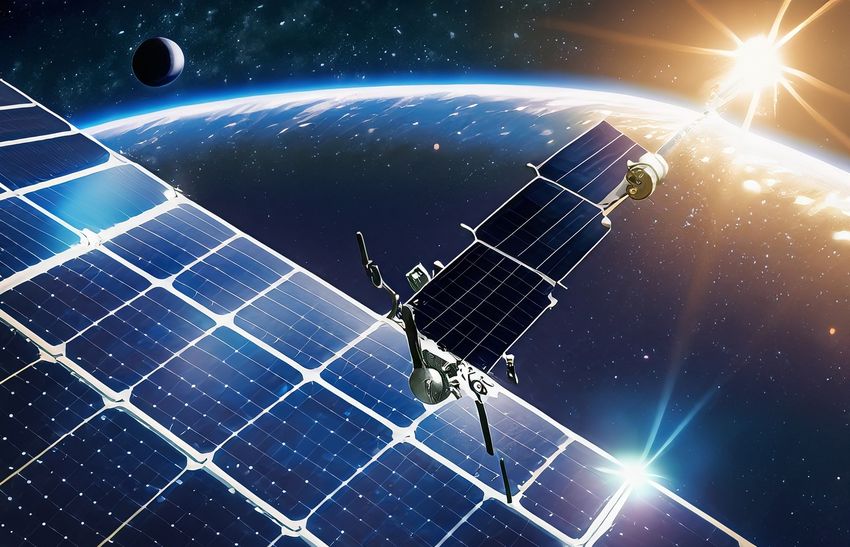Space exploration has revolutionized our understanding of the universe, but behind every successful mission lies one critical factor—power. Satellites, space probes, and crewed spacecraft require a continuous and reliable energy source to operate their instruments, communicate with Earth, and navigate through the vast expanse of space.
In this article, we’ll explore how space electronics are powered, the challenges of generating and storing energy in space, and the latest innovations keeping modern space missions operational.
1. The Importance of Power in Space Missions 🔋🌌
Every spacecraft, from small satellites to massive interplanetary probes, depends on power for:
✅ Onboard Computers & Navigation – Ensuring precise positioning and execution of mission tasks.
✅ Communication Systems – Sending and receiving signals to and from Earth.
✅ Scientific Instruments & Sensors – Gathering data for research and exploration.
✅ Thermal Control Systems – Protecting spacecraft from extreme space temperatures.
✅ Propulsion Systems – Maneuvering in orbit or traveling through deep space.
Without reliable energy sources, space missions would fail. But how do spacecraft generate and store power in the vacuum of space?
2. Power Sources for Spacecraft 🚀⚡
A. Solar Power: The Most Common Energy Source ☀️🔋
How It Works:
- Solar panels convert sunlight into electrical energy using photovoltaic (PV) cells made of silicon or gallium arsenide.
- The electricity is stored in rechargeable batteries to provide power when the spacecraft is in the shadow of a planet or moon.
Advantages:
✅ Unlimited energy source (as long as sunlight is available).
✅ Lightweight & efficient for long-term missions.
✅ No moving parts, reducing mechanical failures.
Challenges:
❌ Less effective in deep space (far from the Sun).
❌ Solar panel degradation due to radiation and space dust.
❌ Limited power during eclipses or planetary shadows.
Examples of Solar-Powered Missions:
- International Space Station (ISS) – Uses large solar arrays to power life support and research systems.
- Mars Rovers (Perseverance, Spirit, Opportunity) – Use solar panels to recharge their batteries.
- Juno (Jupiter Orbiter) – Uses large, high-efficiency solar panels designed to operate far from the Sun.
B. Radioisotope Thermoelectric Generators (RTGs) 🔥⚡
How It Works:
- RTGs generate power by converting heat from the radioactive decay of plutonium-238 into electricity using thermoelectric converters.
Advantages:
✅ Works in deep space, beyond the reach of sunlight.
✅ Operates for decades without the need for refueling.
✅ Reliable and maintenance-free due to no moving parts.
Challenges:
❌ Expensive and complex to produce.
❌ Radioactive material risks require strict handling and safety measures.
❌ Limited availability of plutonium-238.
Examples of RTG-Powered Missions:
- Voyager 1 & 2 (Deep Space Probes) – Still operational after 47+ years thanks to RTGs.
- Curiosity & Perseverance Rovers (Mars Exploration) – Use RTGs to survive cold Martian nights.
- New Horizons (Pluto Flyby Mission) – Relied on RTGs for its journey to Pluto and beyond.
C. Fuel Cells: Chemical Power Systems 🔬⚡
How It Works:
- Hydrogen and oxygen react chemically to produce electricity, with water as the byproduct.
Advantages:
✅ Provides continuous power when fuel is available.
✅ Water byproduct can be used for astronaut life support (on crewed missions).
✅ Reliable and efficient for short-duration space missions.
Challenges:
❌ Limited lifespan as fuel runs out.
❌ Requires complex storage systems for hydrogen and oxygen.
❌ Not suitable for long-term deep space missions.
Examples of Fuel Cell-Powered Missions:
- Apollo Missions (1960s-1970s) – Used fuel cells for life support and power.
- Space Shuttle Program – Generated power for onboard electronics and crew operations.
D. Batteries: Storing Energy for Critical Moments 🔋
How It Works:
- Rechargeable lithium-ion batteries store energy from solar panels or RTGs and provide backup power.
Advantages:
✅ Essential for backup power when primary sources are unavailable.
✅ Lightweight and high energy density.
✅ Rechargeable for long-duration missions.
Challenges:
❌ Degradation over time due to charging cycles.
❌ Limited storage capacity requires efficient energy management.
Examples:
- Hubble Space Telescope – Uses rechargeable batteries to operate in Earth’s shadow.
- Lunar Landers & Rovers – Rely on batteries to survive long lunar nights.
3. Power Challenges in Space 🌍⚠️
Operating electronics in space presents unique obstacles:
🚀 Extreme Temperatures: Spacecraft endure extreme heat (when facing the Sun) and freezing cold (in the dark). Thermal regulation is essential for stable operation.
🌪️ Radiation & Cosmic Rays: High-energy particles can damage electronic components and degrade solar panels over time. Shielding and robust electronics are necessary.
🌑 Lack of Atmosphere: Unlike Earth, space has no atmospheric protection, making electronics vulnerable to micrometeoroid impacts and radiation.
🔄 Energy Efficiency: Spacecraft must optimize power consumption to extend mission lifespans. Low-power electronics and AI-driven energy management help maximize efficiency.
4. Future Innovations in Space Power 🚀🔋
As space exploration advances, new energy technologies are being developed:
🔹 Nuclear Fission Reactors: NASA is working on fission power systems for deep space habitats and Mars colonies.
🔹 Space-Based Solar Power: Future satellites could collect solar energy in space and beam it to Earth wirelessly.
🔹 Advanced Batteries & Supercapacitors: Higher-capacity storage for lunar bases and deep-space missions.
🔹 Wireless Energy Transfer: Powering spacecraft remotely using laser or microwave energy beams.
🔹 Regenerative Fuel Cells: Recyclable chemical power sources for sustainable space missions.
Conclusion 🏁🚀
Power is the lifeline of space missions—without it, satellites, spacecraft, and space stations would cease to function. Whether using solar energy, RTGs, fuel cells, or advanced batteries, engineers continue to innovate ways to keep space electronics operational in the harshest conditions.
As we venture further into deep space—towards Mars, the Moon, and beyond—reliable, efficient, and sustainable power sources will be key to enabling long-term exploration and habitation. The next generation of space missions will rely on even smarter, more efficient power technologies to push the boundaries of human discovery.
🔋 The future of space power is bright—powered by the Sun, nuclear energy, and human ingenuity! 🌟🚀


